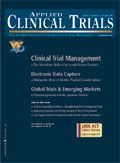Tough Trials Ahead for Europe's Drug Industry
There's plenty to tackle this month, including a debate over efficacy, new ARDS guidelines, and evidence the EMEA is listening.
Before offering comment on recent developments in the European context for clinical trials, this columnist feels obliged to remark on the seismic shifts affecting the European context for medicines—and which will shortly be influencing the context for trials, too.

Peter O'Donnell
The trigger for this reflection is the debate provoked by the first meeting, just at the end of September, of the European Pharmaceutical Forum. That is the pompous title for a ministerial-level discussion of how to keep innovation alive in the European drug industry without crippling European health insurance funds. The debate this process is crystallizing goes to the very heart of what drug innovation—and everything related to it—really means.
The principal protagonists are, predictably, the research-based industry and its traditional supporters, who want prices that will allow new drug development to flourish, in direct conflict with a coalition of health insurance funds and other groupings that want to keep drug bills as low as possible. Nothing new here. What is new, however, is the spotlight that this confrontation is shining on relative efficacy. A decades-old stand-off in Europe between providers and payers is taking on a novel sophistication.
Past and future concerns
Twenty or thirty years ago, the agencies that pay for health care—governments, insurance funds, social security systems—simply dismissed industry demands for higher prices. So the industry got smart and introduced the notion of patient benefit into the public debate: Drug firms argued that they needed better prices not to make more profits but to ensure that ever-better medicines would be developed.
This presented the payers with something of a dilemma. They could not very well respond that they did not want better medicines. Even the most budget-conscious government does not want to tell the people who elected it that they are going to get only the oldest and cheapest drugs. So the payers came up with a new ploy to restrict availability. Yes, of course we want better medicines, they conceded, but if we are going to pay for them, we have to be sure they really are better.
Until now, the innovative industry has stubbornly resisted this line of thinking. It has fought tooth and nail to limit the criteria for product authorization to objective assessment, product-by-product, of quality, safety, and efficacy. In Europe it has managed, so far, to win that combat—as far as authorization is concerned. But it is in grave danger of losing it in respect of pricing and reimbursement. The debate is now underway, in a serious fashion, of how to measure not just the efficacy but the relative efficacy of a new medicine.
The industry has had to choose either to reject this debate out of hand as being utterly ill-founded—and consequently lose any chance of influencing it—or to enter the arena. It has decided to take an active part in the debate. That may give it some chance of influence—but at the very high price of admitting that there is a legitimate debate to be had.
The research-based industry's success—or failure—in this new battle-zone will largely determine the nature of pharmaceutical provision in Europe in the coming years. That, in turn, will materially govern the nature of the product development process in Europe—including the world of clinical trials. At its best, the process could carve out a secure space for trialists to make assessments of new medicines on their own merits, according to sound scientific method. At its worst, it could lead to the subordination of all aspects of drug development, and particularly clinical trials, to crude comparisons based on superficial assessments—rules more appropriate for a beauty contest or a hit parade than for the pursuit of better medicines.
Real-time challenges
Meanwhile, Europe's more specific activities to improve the efficiency of clinical trials are continuing unchecked. The September meeting of the European Medicines Agency's top scientific body adopted new guidance on half a dozen detailed topics. One of them, a new guideline on clinical investigation of medicinal products in the treatment of patients with acute respiratory distress syndrome (ARDS), presents a compelling example of just how complex clinical trials can be, even without the additional burden of demonstrating superior cost-efficacy ratios or other such goals.
The guideline recognizes that "Planning, coordination, implementation, and assessment of such clinical trials present an enormous challenge," stressing the need for attention to factors such as the high rate of mortality, the heterogeneity of trial populations, the need for controlled data, the failure of existing medicinal therapy to influence outcome, and the complicating influences of co-morbid conditions and multi-organ failure. "In order to address these difficulties a high degree of standardization must play a major role in future study design," it insists.
To reduce the degree of heterogeneity, confirmatory trials should be planned and conducted with standardized best practice concomitant treatment and care. It suggests that the most relevant primary endpoint in confirmatory clinical trials for investigation of new medicines in treatment and prevention is "all-cause mortality at day 28 since randomization." The previously accepted "days alive and off ventilator at 28 days after study entry" is no longer recommended as the primary endpoint, since most trials in this indication are open label studies and the decision to wean mechanical ventilation is often subjective.
For exploratory trials, difficulties in identifying the appropriate setting are predictable, it says, citing the complex impact of heterogeneity on the patient population, due to the variety of basic diseases resulting in ARDS and the different concomitant therapy and care. "It may therefore be advisable to restrict Phase II investigations to defined conditions frequently resulting in ARDS, such as sepsis," the guideline suggests.
Even then, it is not anticipated that all patients will respond to the same therapy to a similar extent because of the heterogeneous underlying pathophysiological mechanisms. This expected variability in the characteristics of the patient population decreases the chance of demonstrating efficacy, the guideline concedes.
The draft guideline was under consultation from the autumn of 2005 and will come into effect in April 2007. As part of its new commitment to opening up the black box of regulatory decision-making, the agency has also provided detailed information on the comments it received on the draft—and on the responses from the regulators. This reveals, for instance, that requests for clarification from MSD Belgium led to a modification of the text in respect of early studies. MSD pointed out that early studies would be in patient populations, and the agency response was appreciative. "Thank you for this comment," it observed. "We consider it important to note that early studies cannot be conducted in all cases in healthy volunteers," it agreed, and consequently added to the final text of the guideline the sentence: "A conduct of early studies in patient populations should be considered in some cases, for ethical reasons."
Taking account of comment
What emerges from this exchange is not only that the agency is ready to consider change where change is demonstrated to be valuable, but also that the agency wants to be perceived as being open to reason. In the same spirit, the agency has also just released an overview of comments it received on the draft guideline on the role of pharmacokinetics in the development of medicinal products in the pediatric population. Here too, it demonstrates a constructive response to constructive comment. For instance, many companies' comments to the agency pointed to the risk of international incoherence or inconsistency. "In this vulnerable population with limited blood volume, any new guidance should take into account other already finalized guidance worldwide to ensure harmonization of requirements. It would be unacceptable for differences in requirements amongst agencies to result in additional clinical study burden in the pediatric population," said the European Federation of Pharmaceutical Industries and Associations. The response was: "We agree that this is important. The guideline is to be read with and will be in agreement with the ICH document Clinical Investigation of Medicinal Products in the Paediatric Population."
The same approach underlies the release of a concept paper on the development of a note for guidance on medicinal products for posttraumatic stress disorder and similar exercises in relation to the need for revision of the note for guidance on anti-arrhythmics.
The agency's commendable readiness to consult and listen makes it more congenial as a discussion partner for the industry than many of the national pricing and reimbursement authorities—but this still does not amount to anything like diffidence or deference. As evidence of the teeth it still bares, Sanofi-Aventis has decided to withdraw its July 2005 application for a centralized marketing authorization for its Multaq in rhythm and rate control in patients with atrial fibrillation or atrial flutter. The company said that the additional clinical data requested by the agency could not be provided within the time frame of the current procedure.
Even without the shadow of new battles ahead on economics, the pharmaceutical industry in Europe already faces plenty of challenges.
Peter O'Donnell is a freelance journalist who specializes in European health affairs and is based in Brussels, Belgium.

FDA to Launch National Priority Voucher Program to Speed Drug Reviews for Critical Therapies
June 18th 2025Under the new initiative, companies may receive a voucher enabling FDA review to be shortened from the standard 10–12 months to just 1–2 months following final application submission if the drug addresses US national health priorities.
FDA Outlines Updated Requirement for Placebo-Controlled Trials in Vaccine Research
May 21st 2025In an article recently published by The New England Journal of Medicine, FDA higher-ups Vinay Prasad, MD, MPH; and Martin A. Makary, MD, MPH, wrote that any new COVID-19 vaccine must now be evaluated in placebo-controlled studies.
Phase III SELECT-GCA Trial Results Lead to FDA Approval of Rinvoq for Giant Cell Arteritis
April 30th 2025Rinvoq (upadacitinib) becomes the first oral JAK inhibitor approved by the FDA for the treatment of giant cell arteritis in adults, following robust data from the Phase III SELECT-GCA trial demonstrating its efficacy in achieving sustained remission and reducing glucocorticoid exposure.